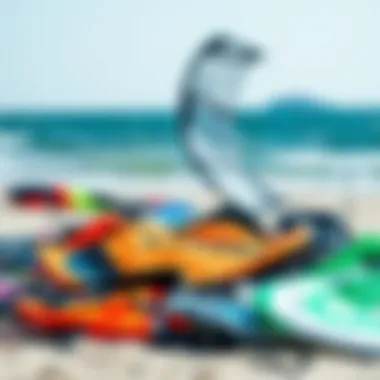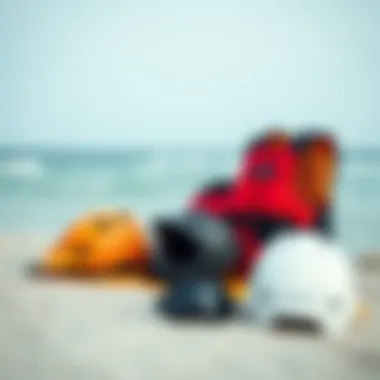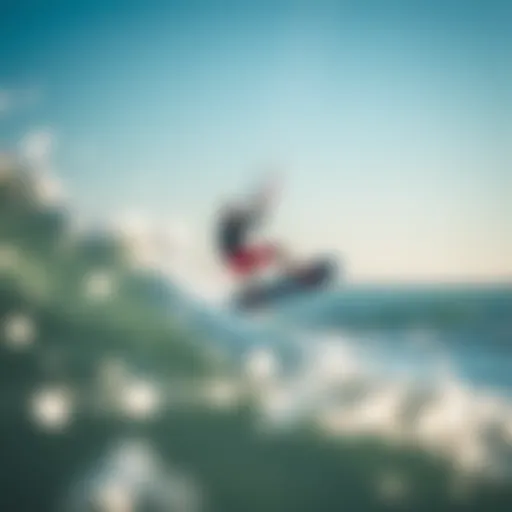Beginner's Guide to Assembling a Kiteboarding Kit


Intro
Kiteboarding can be an exhilarating experience, offering a unique blend of thrill and connection with nature. As a beginner, however, the daunting array of equipment available can leave one feeling overwhelmed. It's important to understand that kiteboarding is not just about hopping on a board and zipping across the water. There’s a method to the madness, and selecting the right equipment plays a crucial role in mastering the fundamental techniques without compromising safety.
In this guide, we will explore techniques for kiteboarding enthusiasts, dissecting both beginner methods and advanced maneuvers that can elevate your skills over time. Our focus will also extend to equipment reviews, featuring kites and boards that align with a beginner’s needs. The aim is to provide a complete understanding of what is needed to kickstart your kiteboarding journey with confidence.
Let's dive into the waters of kiteboarding and discover how to navigate this exciting sport with the right gear and techniques.
Prelims to Kiteboarding
Kiteboarding, combining elements of surfing, wakeboarding, and paragliding, offers an exhilarating experience unlike any other water sport. For those looking to dive into this thrilling activity, understanding its foundational aspects is paramount. This introduction serves as a gateway for beginner enthusiasts. It encapsulates key elements that not only enhance your kiteboarding journey but also ensure a safer, more enjoyable experience.
Understanding the Basics of Kiteboarding
At its core, kiteboarding involves riding on a board while being propelled by a large controllable kite. The interaction between the kite and the rider is fundamental. Beginners should grasp how the kite generates lift and how the wind plays a pivotal role in maneuvering. In basic terms, when the kite is angled in a certain way, the wind fills it, lifting you off the water and allowing for thrilling speed and freedom.
To get started, one might need to understand the types of kites available, including inflatable and foil kites. Each of these has unique characteristics that cater to different wind conditions and skill levels. A beginner typically wants something more stable and easier to control, focusing on the learning curve rather than trick performances.
The importance of safety cannot be overstated. Learning how to handle the kite properly, understanding wind patterns, and maintaining a safe distance from obstacles are crucial in preventing mishaps.
Why Kiteboarding Appeals to Beginners?
Kiteboarding is not only seen as a sport but also as a lifestyle. One of the major draws for beginners is its accessibility; with the right conditions and gear, nearly anyone can give it a try. Many find kiteboarding appealing due to the sense of achievement it offers. As you learn to control the kite and navigate the water, each small success feeds into a larger journey of mastery. Moreover, the social aspect is significant. Kiteboarding draws a community of enthusiasts who often share tips, experiences, and even gear—a factor that enriches the experience even further.
Additionally, kiteboarding is adaptable. Whether you prefer a serene ride across calm waters or the adrenaline rush of jumping waves, the sport accommodates diverse preferences.
Essential Components of a Beginner Kiteboard Kit
Starting off in kiteboarding is all about having the right gear to make your experience as enjoyable and safe as possible. The essential components of a beginner kiteboarding kit truly set the foundation for your adventures on the water. Each element in this kit plays a vital role, whether it's how easy your first ride will be or how in control you feel while navigating the kite and board. A well-thought-out selection ensures that you’re not only learning properly but also staying safe, which is particularly crucial for newcomers to the sport.
Kites: Types and Sizes Explained
Kites are undeniably the heart of kiteboarding. Understanding the types, sizes, and how they interact with the wind will make a significant difference.
Foil Kites
Foil kites are known for their lightweight construction, often made with soft material that inflates with wind. One of their key characteristics is their performance in light wind conditions. This makes them a favorable choice for beginners who may find themselves on the water when the breeze is gentle. The unique feature of foil kites is that they create lift through their shape, allowing riders to glide effortlessly. However, they can be less stable than inflatable kites in gusty conditions, which may pose challenges for novices.
Inflatable Kites
On the other hand, inflatable kites are the most popular choice among beginners. Their structure involves inflatable chambers that maintain the kite's shape, providing excellent stability while in the air. This aspect greatly contributes to ease of use, particularly when you're just starting out. The unique feature here is their ability to relaunch from the water more easily than foil kites, a crucial benefit for those still mastering the basics. However, they can be bulkier and may require more effort to pack and transport.
Choosing the Right Size
Choosing the right kite size can feel daunting, yet it's crucial for your kiteboarding experience. Beginners should consider factors like body weight and wind conditions when selecting a size. A larger kite will generate more power but might be harder to control, while a smaller kite is easier to manage but won't perform as well in light winds. The key point here is finding a balanced size that matches your skill level, maximizing both safety and fun on the water.
The Importance of Selection in Kiteboards
Kiteboards come in a variety of styles, each beneficial for different types of riding. Selecting the appropriate board is essential for comfort and performance.
Directional vs. Twin-Tip Boards
When choosing between directional and twin-tip boards, understanding their respective uses can help guide your decision. Directional boards are suited for those who wish to ride like surfers, providing a more stable ride with a single direction. Conversely, twin-tip boards are symmetrical, allowing riders to ride in both directions, making them excellent for beginners. The unique feature of twin-tip boards is their versatility on the water, especially for learning tricks or transitions, which are common in kiteboarding. However, directional boards often offer better performance in specific conditions.
Material Considerations
Material choices for boards significantly affect durability and performance. Common materials include fiberglass and carbon fiber, with fiberglass being more affordable. However, carbon fiber offers higher strength-to-weight ratios and greater responsiveness, making it a wise choice for those committed to advancing quickly. The key aspect here is understanding your budget and how much you plan on using the board. Sometimes, investing in quality materials can lead to better performance and enjoyment down the line.
Board Size and Shape
Finally, the size and shape of the board come into play. Shorter boards are typically easier to maneuver, making them ideal for beginners still finding their footing. On the other hand, wider boards help with stability and offer a more forgiving ride in choppy waters. The unique feature of a well-rounded board is that it provides adequate floatation while allowing for seamless transitions between maneuvers. Understanding your riding style will guide you in choosing the right dimensions.


Harnesses: The Connection Between Rider and Kite
Harnesses are often underrated, yet they create a crucial link between you and the kite. A comfortable harness can make your ride much more enjoyable.
Types of Harnesses
There are generally two types of harnesses: waist and seat harnesses. Waist harnesses go around your waist, offering more freedom of movement, while seat harnesses provide more support, making them easier for beginners to use. Each has its strong points; waist harnesses are favored by those looking to perform tricks, but seat harnesses excel in comfort and stability.
Finding the Right Fit
Finding the right fit can’t be emphasized enough. A properly fitted harness not only enhances comfort but also ensures that you maintain control over the kite. Be sure to try it on while sitting and standing to see how it feels in various positions. The unique aspect of a good fit is that it can prevent unnecessary fatigue and minimize the risk of injury, which is vital for someone just starting.
Safety Gear: A Non-Negotiable Element
Safety gear cannot be overlooked, especially when you're out on the water. It’s about protecting yourself while enjoying the thrill of kiteboarding.
Helmets
Helmets are essential for safeguarding your head against potential impacts. Many beginner riders might not feel the need for one, but accidents can occur even to seasoned veterans. A good helmet should be lightweight and offer adequate ventilation. Its primary role is to prevent injuries, giving you the peace of mind to focus on your ride.
Impact Vests
Impact vests help cushion your body in case of falls. These vests can absorb shock, reducing the risk of bruises or fractures. Many beginner-friendly models are available, which provide buoyancy while keeping comfort in mind. However, a notable downside is that they can feel bulky at times, which might distract from the riding experience.
Other Protective Gear
Other gear like knee pads, padded shorts, or even gloves can provide additional layers of protection. Knee pads shield your knees from hard landings, and padded shorts can save you from uncomfortable falls. These elements should not be seen as optional but as essential additions to your kiteboarding kit. Without them, the experience might become more daunting, especially for beginners who are still mastering their balance.
Investing in solid safety gear means you can focus on enjoying kiteboarding without worrying excessively about potential injuries.
The essential components discussed here play a crucial role in assembling a beginner kiteboarding kit. From selecting the right kite to ensuring you have adequate safety gear, each step in this journey influences your learning curve and enjoyment in the sport. By understanding these elements, you’re better equipped to make informed decisions that cater to your needs as a budding kiteboarder.
Understanding How Equipment Interacts
In kiteboarding, equipment doesn't just sit in isolation; instead, it forms a dynamic relationship that influences your overall experience on the water. Understanding how equipment interacts—specifically the kite, the board, and the harness—can greatly enhance your performance and enjoyment. Proper compatibility and functionality among these elements reduce the learning curve and set you up for success right from the start.
Kite and Board Compatibility
When you're selecting your first kiteboard kit, the compatibility between the kite and the board is pivotal. Each kite has its own characteristics—think of the size, shape, and type of kite—those factors govern how it will perform with different boards. For instance, if you go for a larger kite, you might want a board that's capable of handling the extra pull. Not only does this improve your maneuverability, while riding, but it also ensures that you're not fighting against mismatched gear.
There are two predominant types of kites: inflatable and foil kites. Inflatable kites are commonly seen among beginners due to their stability and ease of use. Foil kites, on the other hand, can require a higher level of skill for effective navigation. So, if you've chosen an inflatable kite, pair it with a board that naturally complements its attributes, which could mean a twin-tip design for versatility and ease in choppy water. A directional board, conversely, works best with a foil kite due to its specific performance characteristics.
- Important Considerations for Compatibility:
- Kite Size: A larger kite will need a board that can maintain speed and stability.
- Board Type: Certain boards perform better with specific kite types.
- Rider Weight: Heavier riders might benefit from a stiffer board to handle the increased pull from larger kites.
Ultimately, ensure that your choices in kite and board work in harmony to create an enjoyable riding experience. If in doubt, seek the advice of instructors or shops specializing in kiteboarding gear. They'll guide you in creating a kit that fits like a glove.
Kite and Harness Dynamics
The relationship between the kite and the harness is equally crucial. Your harness acts as a vital connection point, allowing you to handle the force generated by the kite without overwhelming your body. Choosing the right harness and ensuring it works well with your kite can make or break your kiteboarding journey.
There are two main types of harnesses: waist and seat. A waist harness is generally preferred by advanced riders, as it allows more movement and lower back support. However, beginners often find that a seat harness offers added security and keeps the power of the kite more centered on the body.
- Dynamics at Play:
- Harness Fit: A snug fit is essential. Too loose, and you'll risk the harness sliding up, causing discomfort. Too tight, and you'll find it hard to maneuver.
- Connection Points: Look at how the harness connects to the kite’s lines. A quality harness will have a spreader bar that distributes the pull evenly across your body, creating less strain as you ride.
Equally important is the consideration of adjustability in your harness. As your skills grow, you might want to tweak the fit or even transition to a different type of harness. A harness that allows adjustments can accommodate various riding styles and preferences.
"Your gear should facilitate ease of riding, not complicate it. Make sure all components work in sync with each other to optimize your performance."


By understanding these dynamics and ensuring that your equipment is compatible across the board, you create a smoother, safer, and more enjoyable experience as you embark on your kiteboarding adventure. This foundational knowledge arms you with the tools you need to tackle the waters with confidence.
Selecting a Beginner Kiteboarding Kit
Selecting the right kiteboarding kit can feel like trying to find a needle in a haystack, especially for those just starting out. The variety of options available can be overwhelming, making it crucial to analyze and evaluate each component of the kit before making a purchase. This section delves into the significance of thoughtfully choosing gear that not only fits your needs but also enhances your experience on the water. A beginner’s kit typically includes kites, boards, and harnesses—all of which work in tandem to ensure that the learning curve is as smooth as possible.
Budget Considerations
Kiteboarding can be an exhilarating sport, but the costs can add up quickly. Setting a budget is often the first step for beginners. This budget will determine what kind of equipment—new or second-hand—you can afford. Usually, a beginner's kiteboarding kit might range anywhere from $1,000 to over $2,500, depending on the quality and brand of the gear.
- Worthy Investment: While it might be tempting to opt for cheaper, lower-quality gear, keep in mind that investing in reliable equipment will pay off in the long run. Cheap gear could lead to performance issues or even safety hazards.
- Hidden Costs: Besides the primary gear, don’t forget to include the price of safety equipment and possibly a few lessons to get you started. A quality helmet, impact vest, and even a proper wetsuit can push your budget higher, but they are essential for your safety and comfort.
Considering your long-term goals and potential upgrades will also assist you in allocating your funds more effectively. Aim to strike a balance between quality and affordability, and don’t hesitate to reach out to local kiteboarding shops for advice on starter kits that could meet your needs without breaking the bank.
Choosing Between New and Used Equipment
One of the critical choices a budding kiteboarder must make is whether to buy new or used equipment. Both options have their pros and cons, and understanding these can guide you towards an informed decision.
- New Equipment: Opting for new gear allows you to enjoy the latest technology, unparalleled performance, and often comes with warranties. New kites tend to be more efficient and can deliver a better experience on the water. However, they also come at a premium price.
- Used Equipment: The second-hand market is teeming with opportunities. Many experienced kiteboarders sell their older equipment to upgrade to the newest models. This can be a golden opportunity for newcomers. It's often possible to find lightly-used gear in excellent condition at a fraction of the retail price.
Things to Keep in Mind:
- Always inspect used gear thoroughly. Check for wear and tear, such as fraying lines or damaged seams.
- Be cautious of older kites that might not conform to current safety standards.
- It can also be beneficial to seek advice from knowledgeable local kiteboarding shops or experienced riders when evaluating used gear.
Useful Tips for First-Time Buyers
When you're ready to dive into the world of kiteboarding, it’s crucial to arm yourself with the right knowledge before making any purchases. The landscape of kiteboarding gear can be a bit overwhelming, especially for someone just starting out. By adopting a careful approach, you not only save time and money, but also enhance your overall experience in this thrilling sport. Here are some essential tips designed to guide you through the maze of choices, ensuring that you invest wisely and safely.
Research and Reviews
The first step in your buying journey should involve thorough research. There’s a wealth of information available online, from forums to dedicated kiteboarding websites. Before splurging on equipment, it’s wise to read product reviews from seasoned riders. These insights often reveal the performance and durability of the gear over time.
- Check platforms like Reddit for community discussions. Search for threads about beginner kits or specific brands.
- Websites like Kiteforum.com often have user-generated reviews that are honest and specific.
- Don’t shy away from YouTube; many content creators test equipment and share their experiences in engaging formats.
When considering reviews, be sure to concentrate on aspects like ease of use, the comfort of gear, and customer service experiences provided by different brands. This information is invaluable, as it helps you to learn which products are favored not just for their performance but also for their support networks.
Consulting Experts and Experienced Riders
While online research is beneficial, nothing beats the advice from those who have weathered the trials and tribulations of learning to kiteboard. Consulting experts and seasoned riders can provide personalized guidance that you might not find online. Don’t hesitate to reach out to instructors at local kiteboarding schools.
- Ask about their experiences: Their wear-and-tear insights can inform you about what to expect as a beginner.
- Inquire about brands: Often, they have preferences based on testing various products over many years.
- Discuss local conditions: Kiteboarding is heavily influenced by environmental factors, and locals know the best equipment suitable for your area.
Additionally, consider joining local kiteboarding groups. Engaging with the community not only provides recommendations but also fosters networking with those who share the same passion. Many experienced riders are eager to share their knowledge and even offer to let you try out their gear before you commit to making a purchase.
"Knowledge is power, especially when it can keep you safe and enhance your learning curve in a sport as dynamic as kiteboarding."
Buying your first kiteboarding kit shouldn't be a hasty decision. By immersing yourself in research and seeking out the wisdom of those with experience, you'll feel confident in your choices, ready to harness the wind and ride the waves like a pro.
Safety Precautions and Best Practices
When venturing into the thrilling world of kiteboarding, safety must always sit at the forefront of your mind. This sport, while exhilarating and enjoyable, involves inherent risks associated with the dynamic interaction between the kite, the wind, and the water. Therefore, understanding safety precautions and best practices is essential for both newcomers and seasoned enthusiasts. Structuring your kiteboarding experience with these considerations not only enhances your safety but also improves your overall enjoyment.
Understanding Weather Conditions
Navigating kiteboarding successfully relies heavily on comprehending the weather. Wind conditions greatly influence kite behavior and your performance on the board. Beginners must learn to assess the wind ranging from light breeze to strong gusts, as each presents distinct challenges.
- Assessing Wind Strength: For starters, a wind speed between 12 to 20 knots is typically ideal for beginners. Anything above this range may tip the scales towards unsafe conditions.
- Effect of Changing Weather: Keeping an eye on the sky can save you from getting stranded. Gusty winds or storm clouds can sneak up quickly. Always check local weather reports, and consider using weather apps designed for extreme sports.
- Location Matters: Some spots may have localized wind effects, known as thermals or eddies, where wind can shift unexpectedly. Learn these factors at your chosen kiteboarding location.
In kiteboarding, understanding the weather isn't just about having a good time—it's about ensuring your safety and that of others around you.
Pre-Flight Safety Checks


Before launching into the air, conducting pre-flight safety checks will keep you, your kite, and your gear in top shape. These checks can be the difference between soaring gracefully or becoming embroiled in a mishap. Here’s how to go about it:
- Inspect Your Equipment:
- Harness and Helmet:
- Communication with Your Spotter:
- Practice Your Release:
- Ensure your lines are free from tangles and damage. Any weaknesses can result in serious accidents.
- Check the kite for holes or tears; a slight rip can cause it to malfunction in the air.
- Confirm your harness is securely fastened and comfortable. An ill-fitted harness can hinder your performance and increase the risk of injury.
- Never head out without a helmet. A lightweight kiteboarding helmet can protect your noggin from unforeseen impacts.
- If you're on a beach with other riders, let someone know your intent to launch. This ensures everyone is aware of your movements, potentially avoiding collisions.
- Familiarize yourself with the quick-release mechanism of your harness. In emergencies, knowing how to detach from your gear can save your life.
A thorough pre-flight safety check is a critical piece of the kiteboarding puzzle, helping you stay safe while navigating the winds and waves with confidence.
"Safety is not just a priority; it’s a way of enjoying the full experience of kiteboarding."
In sum, incorporating these safety precautions and best practices into your kiteboarding routine not only ensures a fun-filled adventure on the water but also promotes a culture of responsibility and mindfulness, crucial for this exhilarating sport. By staying alert to weather and diligently checking your gear, you can focus on what truly matters: mastering the art of kiteboarding.
Community and Learning Resources
Diving into kiteboarding can be both thrilling and daunting. As a beginner, you're not just dealing with gear and techniques; there's a whole world of community and learning resources that can be invaluable in your journey. Connecting with others who share your interest provides not just camaraderie, but also insights and knowledge that can significantly enhance your experience, whether you're still on dry land or already navigating the water.
Local Kiteboarding Schools and Lessons
Local kiteboarding schools offer structured learning for beginners, providing a hands-on approach to mastering this exhilarating sport. Instruction from certified professionals can make a world of difference. They can break down complex techniques into digestible chunks, ensuring that you develop proper habits right from the start.
- Personalized Instruction: These schools cater lessons to suit your individual skill level and learning pace, enabling you to grasp the fundamentals without feeling overwhelmed.
- Safety First: In a controlled environment, schools usually emphasize safety measures. They teach you how to assess wind conditions, use safety gear effectively, and execute emergency procedures.
- Networking Opportunities: Joining a school not only gets you lessons but also connects you with other students, instructors, and even local kiteboarding enthusiasts. This can lead to friendships and future riding buddies.
- Equipment Rental: Many schools provide rental gear which allows you to try different equipment styles before investing a chunk of change in your own kit. This can help you make informed purchasing decisions down the line.
Whether you’re whipping in and out of the waves or just starting out on the beach, schools like Kiteboarding School USA or Kiteboarding Revolution offer tailored programs that can cater to both individuals and groups.
Online Forums and Communities
In today’s digitized world, online forums and communities open up a treasure trove of resources for aspiring kiteboarders. Platforms like Reddit, for instance, host communities of kiteboarding enthusiasts sharing experiences, advice, and even gear recommendations. Engaging in these conversations can broaden your understanding and give you varied perspectives.
- Advice Sharing: Online platforms sometimes serve as the quickest way to get answers to your questions. Have a specific query? Chances are, someone else has asked the same in forums like Kiteforum.
- Video Tutorials: Websites like YouTube have countless videos from professionals and seasoned riders who breakdown techniques visually. This can be particularly helpful for those who learn better through visual cues.
- Local Meetups: Many communities organize meetups, allowing you to practice with others. You can find local events in Facebook groups or platforms like MeetUp.com, creating opportunities to connect and learn from fellow kiteboarders.
- Brand Insights: Following brands on social media can also provide exclusive content. Brands like Naish and Cabrinha often share tips, videos and the latest innovations, which could help enhance your skill set and knowledge of the sport.
In summary, whether it's gaining knowledge through lessons at a local school or connecting with other riders online, these community and learning resources provide essential support for beginners stepping into the exhilarating world of kiteboarding.
Remember: The greatest lessons often come from shared experiences, so don’t shy away from reaching out to others!
For further engagement, check out Kiteboarding Forums on Reddit, or consider joining groups on Facebook. Explore articles on sites like Britannica for historical perspectives and gear guides.
Final Thoughts and Future Considerations
As you wrap your head around the essentials of assembling a beginner kiteboarding kit, it's worth pondering some overarching thoughts. Kiteboarding is not just a hobby; it’s an adventure that can bring both exhilaration and a sense of community. Selecting the right gear, understanding safety practices, and continuously assessing your progress are pivotal in establishing a strong foundation for your kiteboarding journey. The decisions you make today will shape not only your immediate experience but also your long-term development as a kiteboarder.
Evaluating Your Progress
The concept of evaluating your progress might seem simple, but it is crucial in kiteboarding. Regularly reflecting on what you’ve learned can greatly enhance your skills. After every session, take a moment to think about what went well and what areas might need a little fine-tuning. Keep a journal of sorts, jotting down your successes and setbacks. This can be as straightforward as noting:
- Skills mastered: Did you nail that jump or perfect your carve?
- Challenges faced: Were you struggling with your kite control or foot placement on the board?
- Next steps: What skill do you want to tackle next?
Monitoring your progress isn’t just about following a checklist; it’s about growth. Looking back helps you appreciate how far you've come, while clearly defining further goals helps keep you motivated. Embrace feedback from peers or instructors. Sometimes, a fresh pair of eyes can shine a light on areas for improvement that you might overlook.
Upgrading Equipment as You Improve
As your skills improve, the question of upgrading your equipment often bubbles to the surface. It's a natural progression; as you become more proficient, you'll begin to see limitations with your current gear. Recognizing when and what to upgrade can be a game changer.
Initially, you might want to focus on getting quality equipment that suits a beginner's needs. However, when you feel comfortable on the water and are craving more performance, consider the following:
- Kite Size: A kite that felt perfect at first may not suit your advanced maneuvers. Choose a kite that provides more range and stability for jumps.
- Board Shape: Explore different designs. A directional board can help with speed and control but requires a different technique compared to twin-tips.
- Harness Type: As techniques advance, a comfortable and supportive harness becomes increasingly important. A harness that reduces strain and optimizes control can lead to better performance.
When upgrading, focus on your specific needs. Visit local shops or community forums to test equipment firsthand before making a commitment. Ensure that the enhancements align with your style, rather than just hopping on the latest trend. Every piece of upgraded equipment should feel like an extension of you, enhancing your experience rather than complicating it.
Embrace this new chapter as part of your kiteboarding evolution. Remember, upgrading is not just about having the best gear; it's about enhancing your capability and enjoyment on the water.
"Success in kiteboarding is not only what you ride but how you ride it."
As you gather your equipment and thoughts, take solace in the knowledge that this is an ongoing journey. Continue to learn, adapt, and refine your skills as you navigate the dynamic world of kiteboarding.















